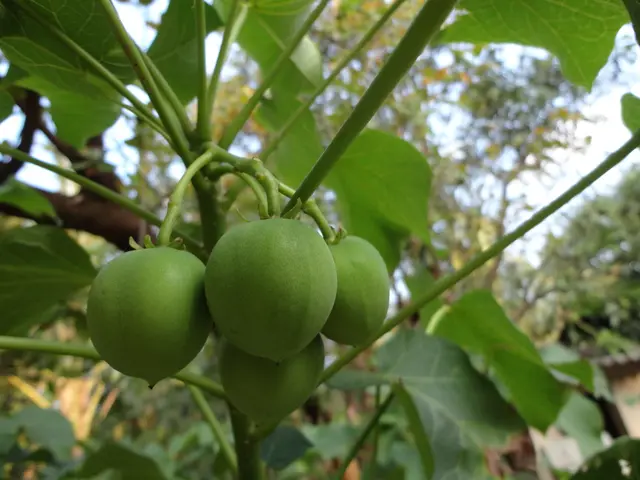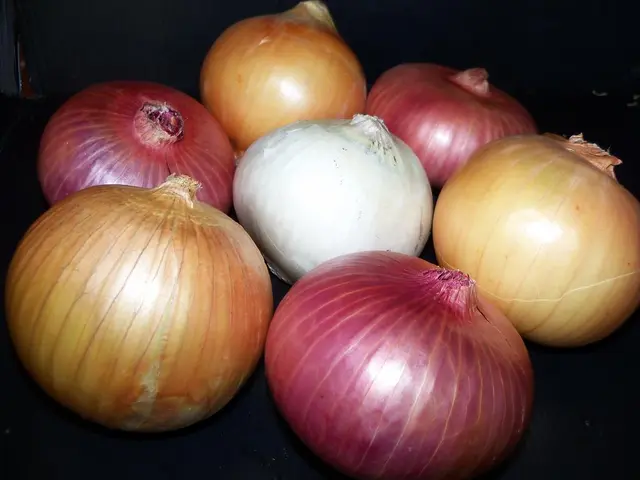Spring gardening tips: Essential frost protection methods for green thumbs
Spring gardening can be a rewarding endeavor, but a surprise frost might put a damper on your new blooms. Knowing which plants are most vulnerable and how to protect them using appropriate materials and techniques can save your garden from frost damage.
Spring Frost's Threat to Plants
Image Credit: Shutterstock.
Planting annuals and seedlings early in the spring has numerous advantages, but it also comes with risks – unpredictable spring weather that can ruin your hard work. Springtime's wild temperature fluctuations can damage seedlings, cold-intolerant plants, blossoms, new growth, and those newly planted in your garden. In extreme cases, your plants may succumb to the cold temperatures entirely.
Frost Protection Strategies
To ensure your plants survive the extra chilly nights, we've tapped into the knowledge of horticulture experts, university extensions, and master gardeners across the country, including the University of Kentucky, University of Georgia, Minnesota State Horticultural Society, North Carolina Cooperative Extension, and Texas Master Gardeners.
How Cold is Too Cold?
Image Credit: Shutterstock.
According to the Horticulture magazine, the National Weather Service only issues frost and freeze warnings after the (average) last frost date for your area, so consider planting seedlings and annuals after that date. Cold-tolerant plants are usually fine, but even the hardiest of them may need help when temperatures plummet below 25°F.
Rick Durham, a horticulture professor at the University of Kentucky Extension, explains that if a cold snap occurs early in the season and temps drop down in the 30s, it won't have a significant impact on plant development, except maybe for small blooming shrubs and fragile new plants. However, it can become more problematic if a frost or freeze comes later, like a mid-May freeze in Kentucky.
In general, cold-tolerant plants like lettuce, asparagus, and rhubarb can withstand temperature drops as long as they don't drop below 20°F; if it gets that cold, covering them is recommended. Blooming blueberries and strawberries should be covered in the event of frost, but you don't need to worry about berry plants that produce later. Some flowers, such as daffodils, pansies, and primrose, are excellent frost-resistant plants and typically recover after the temperature warms.
Why is Frost Harmful?
Image Credit: Shutterstock.
According to the University of Georgia Extension, it's not the cold air itself that is an issue; rather, it is the frost that forms within the plant that causes harm. When frost occurs, icy crystals form inside the plant and shred it from the inside out. Interestingly, woody plants that are dormant over the winter are safe from this icy demise because the stems contain sugars that prevent ice from forming. Even so, they are still vulnerable once the temperature warms, as water replaces the sugars and new growth begins anew.
Covering Up Plant Protection
Image Credit: Shutterstock.
The Minnesota State Horticultural Society advises covering rows of seedlings for both raised bed gardens and in-ground to keep the cold air out and the soil's heat in. If you have raised beds, simply drape the sheeting over the vulnerable plants and staple it to the edges of the bed. Placing rocks or bricks around the edges works, too. For an in-ground garden, try propping up the center like a tent with small garden stakes, so the sheeting doesn't touch the plants. The key is to create air space between the seedlings and the cold temperature.
Another idea is to build an inexpensive framework around your garden in advance. Texas Master Gardener Diane Kufert suggests using flexible PVC pipe over rebar to create an arch framework. Draping blankets or covers over the frame will offer great protection from frost while keeping the heavy fabric off the plants. Wooden stakes or short-wire garden fencing can also be used for a DIY frame.
Material Choices for Covering Plants
Image Credit: Shutterstock.
You have a variety of choices for materials of varying thickness when it comes to covering your plants. One option is lightweight row cover, a thin, gauzy material. The University of New Hampshire Extension claims that the lightweight variety only provides about 2°F of protection from frost, while heavyweight row covers provide 6° to 10°F of protection. For added protection, frost covers can be used, such as old blankets or bed sheets, burlap, or nursery or tobacco cloth. Be cautious when using heavy materials, as they may damage delicate plants with their weight.
Is Plastic a Good Covering?
Image Credit: Shutterstock.
There is conflicting advice about using plastic to cover plants. You can certainly use plastic sheeting, but it's trickier. Kufert cautions gardeners about using plastic, as it can damage plant tissue when the temperature warms up. North Carolina Cooperative Extension agent Rebecca Bradley suggests not using plastic at all. The crucial point to remember is that plastic should never come into direct contact with plants.
Other experts, like the UGA Extension, recognize the benefits of plastic for retaining heat. Yet, even they highly recommend removing the plastic in the morning by 8 am, as soon as the sun is out. Plastic can also be used as an added layer of protection, on top of another covering.
Creative Ways to Cover Plants
Image Credit: Shutterstock.
Take special care to protect small, fragile seedlings. One effective method is to use DIY cloches: small, individual greenhouses for plants. These can be made from large plastic drinking cups, empty pots, buckets, cardboard boxes, or even repurposed, plastic milk jugs. Take caution when creating your DIY cloches to ensure proper air circulation and avoid overheating.
Mulching for Warmth
Image Credit: Shutterstock.
Mulching around the plant roots is another method of providing insulation from frost. Seedlings, small plants like strawberries, and any other sensitive plants in your garden will benefit from a thick covering of pine straw, leaves, or mulch. Don't forget to remove the mulch once temperatures rise, as plants need sunlight and air circulation.
Protection for Potted Plants
Image Credit: Shutterstock.
If temperatures are expected to drop between 29° and 32°F – a light freeze – consider moving potted plants close to the house, preferably in a sheltered spot that receives sunlight. For a hard freeze (25° to 28°F), it's best to move the plants into a garage, barn, shed, or other enclosed structure to protect them.
If moving the plants isn't possible, covering them is still a good idea. Choose a covering that is large enough to drape down on all sides and lie flat on the ground to capture the heat retained in the soil.
Tip: Don't bring potted plants inside to warm up, as they will suffer more damage with an abrupt change in temperature.
Watering for Frost Protection
Image Credit: Shutterstock.
If you have fruit trees, consider watering the soil around their base before a freeze. The wet soil stays warmer, and as the water cools, it gives off heat, which rises and protects the blossoms from the frost. Minnesota State Horticultural Society reports that orchards and even some berry farmers use this method.
It's also a good idea to water your plants a few days before the temperature is expected to drop. And since it's spring, chances are – Mother Nature may take care of that for you!
Relax and Prepare
With the season's wild weather swings, it may seem like your plants are doomed to frostbite, but rest assured – they are often quite resilient in the face of cold weather. Many plants easily survive a surprise snow shower, so there's hope! By following these expert-recommended strategies, you can effectively shield your spring garden from frost and ensure a healthy start to your gardening season.
Author
- Tobey Young Over a decade ago, Tobey's gardening journey began with bare root strawberry plants from a school fundraiser. That small start soon grew into a passion, outgrowing her suburban yard. Today, she lives on a hillside hobby farm in Indiana overlooking the Ohio River with her husband, two kids, and an adorable mix of mini donkeys, goats, and chickens. She balances her days between freelance writing, homeschooling the kids, and tending to farm life. View all posts
Spring gardening can pose challenges, as unpredictable spring weather might affect your tender seedlings and plants. To protect them from frost damage, consider planting after the average last frost date in your area. Cold-hardy plants like lettuce and asparagus can endure temperatures as low as 20°F, while blooming blueberries and strawberries may need coverage during frost.
When covering plants, lightweight row covers offer minimal protection, while heavyweight ones provide more insulation. For raised bed gardens, sheets can be draped over rows and stapled to the edges. In-ground gardens can be protected with a tent-like structure made of stakes, blankets, and garden fencing.
Plastic sheeting can be used for heat retention, but it must be removed once the sun is out and should never come into contact with plants. Flexible PVC pipe over rebar can form a protective framework around your garden, and homemade cloches made from various household items can protect seedlings from frost.
Mulching around the plant roots can also offer insulation from frost, but the mulch should be removed once temperatures rise to allow sunlight and air circulation. To protect potted plants, move them indoors, or near a sunny, sheltered spot, if possible, during a light freeze. For a hard freeze, move potted plants to an enclosed structure.
Watering the soil around fruit tree bases before a freeze may help protect the blossoms, as wet soil absorbs and releases heat. It's also beneficial to water your plants a few days before cold weather sets in. With these strategies, you can effectively shield your spring garden from frost, ensuring a healthy start to your gardening season.








